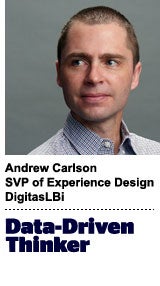 “Data-Driven Thinking” is written by members of the media community and contains fresh ideas on the digital revolution in media.
“Data-Driven Thinking” is written by members of the media community and contains fresh ideas on the digital revolution in media.
Today’s column is written by Andrew Carlson, senior vice president of experience design at DigitasLBi.
Advertising agencies have always been on the forefront of creativity and engagement, innovating new ways for brands and customers to interact with one another. The advent of the web as a consumer necessity has introduced incredible new opportunities – and challenges – for the industry. Amid these changes, standard creative processes have become outdated.
Year over year, technology continues to become more sophisticated, nuanced and prevalent. Now, more than ever, agencies need to bring ideas to reality quickly and effectively. The reality, however, is that digital projects – such as websites, interactive apps and other experiences –can take over a year to go from a brainstorming session to full deployment, which is far too slow in today’s digital landscape.
These projects often get passed around multiple departments, from the user experience team to the creative department to IT folks and beyond. Over time, the initial, creative vision fades due to lack of continuity, leading to multiple rounds of feedback and correction between the agency and the client.
After working in the creative field for almost 15 years, I’ve seen this process take place time and time again. For an example of how to overcome this slow and cyclical process, ad agencies should look beyond their sector to the software industry.
Software companies pride themselves on “moving fast and breaking things,” as the famous Facebook motto goes. Time is of the essence when competing for users, so these companies release new products and updates on a quarterly or monthly basis – not yearly. Pay attention to the update frequency on mobile apps and you will notice you are getting monthly or even weekly incremental changes. Fixes happen fast because today’s customers won’t accept them any other way.
There are many lessons that advertising agencies can take away from the software industry, especially in regards to their use of data, deployment speed and flexibility.
Data Can Inform The Brainstorming Process
Data fuels the technology industry, and access to this wealth of information has completely changed the way companies release products.
Boston Consulting Group recently said big data analytics was the second largest driver of innovation in today’s economy. Many software companies look at data to assess if and where there are gaps in the market and how customers are interacting with competitors’ current offerings as well as with their own products.
As a first step in a digital project, ad agencies should research what consumers are interested in and see which products and ideas have produced the best responses. They should collaborate with their clients to learn about their respective industries, and analyze available data in an efficient and timely manner to inform their next steps.
Those insights will save them even more time later in the creative process.
Deployment Speed Is Key
As soon as software companies recognize a problem with a product, many rapidly create and test new ideas to improve their offerings.
Google Venture’s Sprint piloted this rapid idea-testing process, taking five days to create and test prototyped products with focus groups before building them out. This quick response can be achieved by streamlining key decisions or working closely together with small teams.
In the advertising industry, problems often arise from confusion between departments and concepts get lost in communication. While several stakeholders are involved in carrying out projects in advertising, folks in the software industry work toward an end result in one unified group. The open-source software community, for example, has millions of contributors, but everyone is aligned on the goal and desired outcome. These developers also work together rapidly to address unexpected issues. Ad agencies can take a page from the open-source community’s book and work openly together on projects for fast releases.
Flexibility And Agility Are Essential For Customer Satisfaction
Consumer interests have always changed quickly, and that’s especially true in today’s connected, always-on world. To keep up with expectations, software companies quickly adjust their offerings without disturbing the consumer-facing product.
Unlike in traditional advertising, work in digital advertising really begins when the product is live. Ad agencies should keep a close eye on available data to understand how customers are interacting with their creative projects, and adjust projects according to new trends in a quick, efficient and seamless manner. The ability to iterate based on actual patterns of use is what separates the digital products we love from the ones we never look at again.
The prevalence of the web in all aspects of life and society present great opportunities to ad agencies. We can become more creative and interactive than ever before, but we need to speed up our time from concept to delivery.
Leaders of the software industry provide great inspiration with their use of data, speed and flexibility. These learnings can help everyone across the advertising industry better serve both clients and consumers, and finally make the transition into the future of the digital age.
Follow Andrew Carlson (@andrewsrowe), DigitasLBi (@Digitas) and AdExchanger (@adexchanger) on Twitter.













